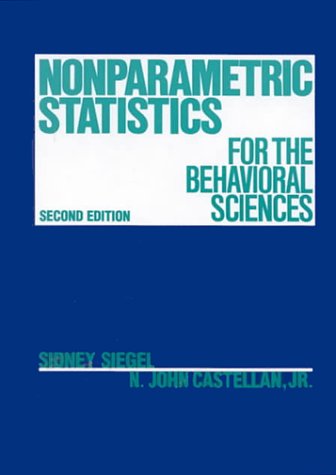Nonparametric statistics for the behavioral sciences book
Par morgan grisel le samedi, avril 1 2017, 19:41 - Lien permanent
Nonparametric statistics for the behavioral sciences . Sidney Siegel

Nonparametric.statistics.for.the.behavioral.sciences..pdf
ISBN: 9780070573, | 332 pages | 9 Mb

Nonparametric statistics for the behavioral sciences Sidney Siegel
Publisher: McGraw-Hill
Siegel S: Nonparametric statistics for the behavioral sciences. New York, NY: McGraw-Hill; 1956:68-75. Howell (Eds.), Encyclopedia of statistics in behavioral science (pp. Siegel S, Castellan NJ Jr: Nonparametric Statistics for the Behavioral Sciences. Fundamental Statistics for the Behavioral Sciences, 7th Edition by David C. Nonparametric statistics for the behavioral sciences (2nd ed.). SAS Institute Inc: The MIXED Procedure. This is one reason why I don't make a big deal of the parametric/non-parametric distinction in my Serious stats book and probably partly why a recent article in APS Observer annoyed me so much. This chapter gives an overview of the typical statistical exploratory and confirmatory tools available and suggests case-specific guidelines for a reliable statistical approach that can be used for 2DE analysis. On nonparametric statistics I'm not a big fan of the term "nonparametric statistics", or at least how it is used in psychology and related fields (e.g., education and health research). Serious stats: A guide to advanced statistics for the behavioral sciences. Siegel S, Castellan NJ: Nonparametric statistics for the behavioral sciences. We used the formulas in the popular Nonparametric Statistics for the Behavioral Sciences by Siegel and Castellan, Jr. Martinke (Eds.), Configural frequency analysis (CFA) and other non-parametric methods (pp. Actually, yes: For (1), that is just a hypothesis test, and the social sciences have long commonly made good use of that subject, e.g., as in. (Original work pub-lished 1759). This investigation examines three hypotheses for the low utilization of response Nonparametric statistics for the behavioral sciences (2nd. The theory of moral sentiments ( D. New York, NY: McGraw-Hill; 1988:399. Randolph University of Joensuu, Finland Abstract Given the impressive results of response cards on student participation, academic achievement, and classroom behavior, it is surprising that response cards are not more widely utilized. In case you wonder, as I did, Table D in Nonparametric Statistics for the Behavioral Sciences indicates that the probability of this distribution being random is 5.9%, i e it's not statistically significant at the 5%-level. Oxford, England: Clarendon Press.